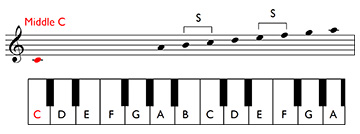5.8 Minor scales: the natural form
The major scale is only one of the group of scales used in both western art and western popular music as the basis of composition. Another is the minor scale. As we’ve seen, the major scale has only one form generated by the intervallic pattern, T T S T T T S. By contrast, the minor scale has three forms, which all use the same key signature:
- natural
- melodic
- harmonic.
We know that the key signature for C major has no sharps or flats. For the A minor scale, this is the same. Here is the natural form of the scale:
Example 50

You’ll notice that it is similar to the major scale in that it can be played on a keyboard using only the white notes. The only difference is that it begins not on C, but on A. However, this alters the intervallic structure. Instead of T T S T T T S, we get:
| A–B | Tone |
| B–C | Semitone |
| C–D | Tone |
| D–E | Tone |
| E–F | Semitone |
| F–G | Tone |
| G–A | Tone |
We can represent this symbolically as T S T T S T T.
